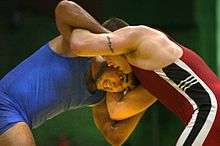Wrestling in India
Wrestling is considered one of the oldest sports in the world and wrestling has a long history in India.
 | |
| Governing body | Wrestling Federation of India |
|---|---|
International competitions | |
Olympics: Bronze: Khashaba Dadasaheb Jadhav in 1952, Bronze: Sushil Kumar in 2008, Silver: Sushil Kumar in 2012, Bronze: Yogeshwar Dutt in 2012, Bronze: Sakshi Malik in 2016 | |
History
Wrestling has been popular in India since ancient times, it was mainly an exercise to stay physically fit. The wrestlers, traditionally, use to wear a loincloth, langota. In Ancient India wrestling was most famously known as Malla-yuddha. One of the premier characters in Mahabharata, Bhima was considered to be a great wrestler of the time, and some of the other great wrestlers included Jarasandha, Keechaka and Balrama. In the other Indian epic, Ramayana also mentions wrestling in India and Hanuman is described as one of the greatest wrestlers of his time.
During the Muhgal rule who were of Turko-Mongol descent, the influence of Iranian and Mongolian wrestling were incorporated to the local Malla-yuddha to form the modern Pehelwani.
Wrestling in India is also known as Dangal, and it is the basic form of a wrestling tournament. In 2018, Khushi Kothale, Akita Sharma and Mahin Sikha got selected for the 3rd round of Asian Games Women's freestyle wrestling. 2nd round was held in Pune where Khushi Kothale, Akita Sharma and Mahin Sikha showed excellent performance, though, Khushi Kothale was leading on the score board(6-2) against Russia. We heartly congratulate the work done by the trio. It is also called kushti in Punjab and Haryana. The wrestling in Punjab and Haryana will take place in a circular court with soft ground which in Punjabi is called an "akharha". Two wrestlers will continue to wrestle until the back of one touches the ground. The winner will parade the court with the loser following him.[10] The wrestlers are called Pehlwans who train with modern weights and traditional weights such as a Gada (mace). The aim of kushti is to wrestle the opponent and to block the other player.
See also
Further reading
- Rudraneil Sengupta, 2016, Enter the Dangal: Travels through India's Wrestling Landscape.
- Joseph S. Alter, 1992, The Wrestler's Body: Identity and Ideology in North India.
- Saurabh Duggal, 2017, Akhada: The Authorized Biography of Mahavir Singh Phogat.